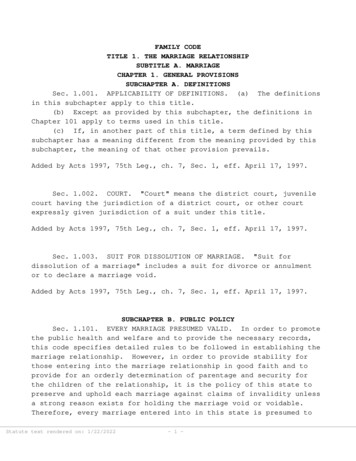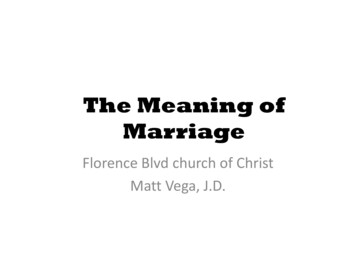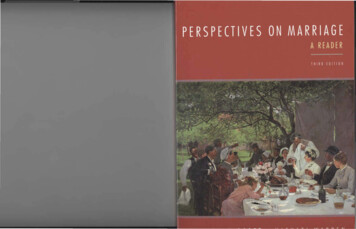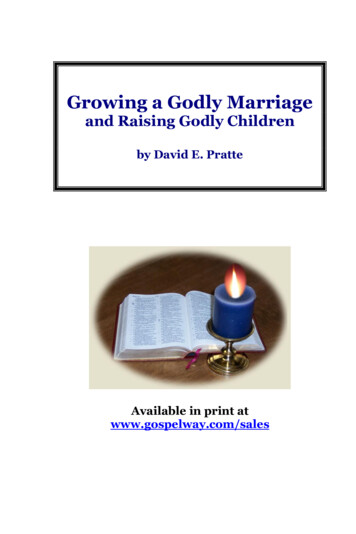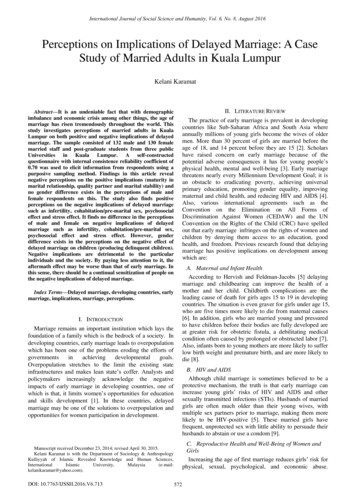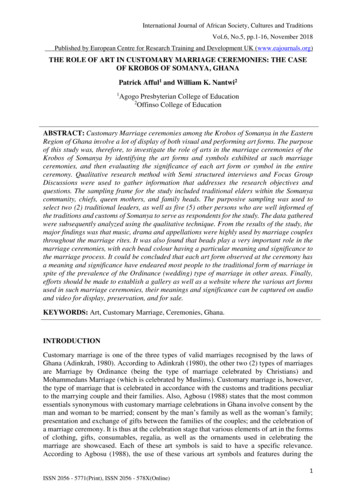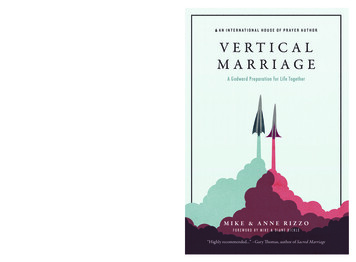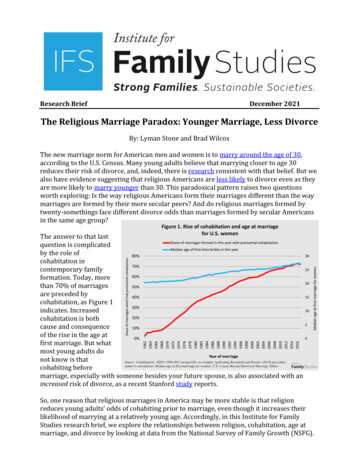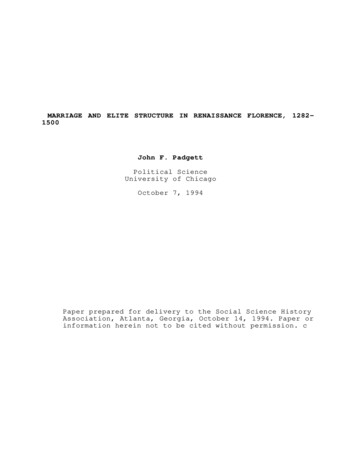
Transcription
MARRIAGE AND ELITE STRUCTURE IN RENAISSANCE FLORENCE, 12821500John F. PadgettPolitical ScienceUniversity of ChicagoOctober 7, 1994Paper prepared for delivery to the Social Science HistoryAssociation, Atlanta, Georgia, October 14, 1994. Paper orinformation herein not to be cited without permission. c
1MARRIAGE AND ELITE STRUCTURE IN RENAISSANCE FLORENCE, 12821500John F. PadgettUniversity of ChicagoThis conference paper is an interim report from a largescale project to trace transformations in Florentine elitenetwork structures over two centuries. In this paper, Iconfine myself solely to a description of previously iage.Knowledgable readers will immediately see that these timately, I am primarily interested in the politicalimplications of the trends I herein describe. But for now I donot engage in interpretation, explanation, or argumentation. Iintend simply to lay out some new facts. In particular, mylack of citation to relevant secondary literatures [a flaw tobe corrected in future drafts] should not be taken as anindicator of my lack of knowledge of these excellent works.Data and SourcesThe data set, only a portion of which is used here,comprises probably the most extensive collection of historicalnetwork information ever assembled. The eventual book-lengthgoal of this project is no less than an Annales-style "totalhistory" of interlinked transformations in Florentine ries.Needless to say, this goal is even conceivable only because ofthe astonishing richness of the Florentine archives, andbecause of the impressive diligence of many Florentinehistorians besides myself. The data set itself can bedescribed in five parts: marriage networks, economic ion,andpolitical party/faction memberships.About 10,500 dated marriages among Florentine surnamedfamilies, over the period 1282-1500, have been collected andcomputerized from a variety of sources. Through travel to sixrare-book collections in the United States, I coded andcomputerized 38 Renaissance Florentine family-trees from theexcellent early-nineteenth century geneologies of LuigiPasserini. Through two separate month-long trips to theArchivio di Stato in Florence, I coded and later computerizedthe marriages of 298 families of somewhat lesser renown from
2the 13-volume compilation of Pierantonio dell'Ancisa, whoworked in the mid-1600's. These compilations were based inturn for the most part on series of notarized contracts (e.g.,regarding dowries), the bulk of which are now lost. Inaddition, I coded and computerized 12 family-trees from amiscellany of histories available in the U.S. In all, I codedas many marriages as I could find in the sources for 335family-clans. (Numbers do not add because of some multiplecodings.) Since I coded all the marriages engaged in by these335targetfamily-clans, the number of total familiesrepresented in the data set is far more than this. (I haveattributional information on 960 families; thus 960 is theeffective limit on sample size. In most analyses herein, themarriages of 500-600 family-clans are being analyzed at atime.)Details of sampling, coding, and sources of error will bereported in future documents. Suffice it to say here thatsnowball sampling was employed, via multiple trips to thearchives. Given the percent coverage that eventually lsampling do not much pertain here. As is shown in figure 1,which links these marriages to various tax censuses of theentire Florentine population (about which more below), Iestimate that my 10,000 sample covers about 40% of allmarriages ever made among families with last names. Dueprimarily to the sources and only secondarily to the tatusdeclines. At the upper end of the scale, percent coverage forthe richest 500 households in the city increases from 65% to90% over time, as is also shown in figure 1.Economic networks do not figure in this paper, but I willbriefly note for the record two data sets that have beenassembled to date. An advanced student colleague of mine, PaulMcLean, has coded and computerized from the 1427 tax 000endebtedness relations--that is, who owes money to whom, forwhat type of prior transaction. This massive cross-sectionalcoding was done in its first wave at the Univerity of Chicago,using a microfilmed copy deposited here by the late DavidHerlihy, and in later waves by Paul at the Archivio di Stato,to fill in gaps in the microfilm.Paul and I also have assembled data on economicpartnerships across time. From guild records in the Archiviodi Stato, I have assembled (but not yet computerized) analmost complete time- series of all partnerships and firms inone industry--banking--over the period 1340 to 1480. From sentially a census of all partnerships and firms in thecity, across all industries. And for 1451, Anthony Molho has
3published a similar almost-complete list of partnerships andfirms, across all industries. We anticipate much valuableinformation on changing market, industrial, and firm structurefrom these data sources in future (joint and otherwise)publications.Under the topic of "other social networks" are two items:(1) From a rich prosopographical secondary source, a book byDale Kent entitled The Rise of the Medici, a previouscoworker, Christopher Ansell, and I coded nine different typesof social ties, along with political party memberships, forthe period 1420-1434. Analyses of these data have already beenreported in a 1993 article by us in the American Journal ronage letters, which request favors of various sorts. Paulhimself will report on these texturally-rich qualitativedocuments in future publications.In addition to these systematic social network data, overtime, I have assembled and computerized a variety ofattributional data on each of 960 family-clans whom I havedetected in Florentine marriages sometime over the two-centuryperiod. (A number of these families, of course, flow into andout of history over time.) Often, but not always, I candisaggregate further to the household level of analysis. Theseattributional data can be summarized in three categories:social status, wealth, and residence.During this period of republicanism, Florentines judged afamily's social status by how politically old it was--that is,by the date the first member of the family was admitted to thePriorate, the governing body of Florence. Najemy and Kent xhaustive listing is the eighteenth-century Mecatti volumes,located in the special collections of the Newberry Library inChicago. This source not only contains many more families'first dates than Najemy and Kent, but also it contains thedates of every Prior every family ever had--in other words, itrecords the political histories of all families' s,thisinformation has been coded and computerized.As is well known among Florentine historians, magnateswere an important special category of socially old icipation in offices. Lansing provides a tabulation oftheir identity.Wealth data over time for so many households and clans isquite difficult to obtain, but with the aid of otherFlorentine historians numerous tax censuses have now been
4computerized. The 1427 catasto was computerized and generouslymade available for public access by the late David Herlihy andChristiane Klapisch. They also computerized 10% samples of the1458 and 1480 catasti. Samuel Cohn gave to me his microfilmcopies of the 1351 estimo and the 1378 prestanze, the lastnamed families of which I have (with much effort) transcribedand computerized. Lauro Martines and Anthony Molho published,in appendices to their books, the wealthiest 500 households ofthe 1403 prestanze and of the 1458 and 1480 catasti,respectively. [Julius Kirshner and Anthony Molho have alsocomputerized the entire 1480 catasto. Perhaps they may grantme access to it in the future.] The sum total of thesedocuments gives me a wealth time-series for 1351 ete),1458(partial), and 1480(partial).The information assembled by me from these tax sources pending on the document) of head of household, residence ofhead of household (at the gonfaloni or ward level), and forcomplete censuses, number of households per family-clan.Wealth and residence of course also can be aggregated to thetotal clan level. Dispersion of clan residence acrossgonfaloni is a useful measure of clan "cohesiveness" or"solidarity" (at least as a first cut), which can be manyfamilies, is contained in the tables of Raveggi et al.Finally, membership in political factions or parties hasbeen coded, mostly from secondary sources. Raveggi et al.provide membership listings of Guelfs vs. Ghibellines (1260's)and of Blacks vs. Whites (1300's and 1310's). From the text ofBrucker's book the composition of the Albizzi and Riccifactions (1340's and 1350's) has been identified. Najemyprovides useful information on elite supporters and opponentsof the Ciompi rebellion (1378). D. Kent gives a list of Medicisupporters and opponents, on the eve of the Medici takeover(1434). Rubinstein provides information useful for identifyingMedici supporters thereafter. Sapori has also published a listof 1449 Medici partisans. In the 1964 Bollettino Senese diStoria Patria, there is a reprinted list of signators usefulfor identifying anti-Mediceans in 1466. Only anti-Mediceansfrom later Pazzi (1470's) and Savonarola (1490's) revoltperiods have not yet been identified and computerized.Elite ConcentrationA convenient starting-point for tracking broad trends inFlorentine inter-marriage is to focus on the degree to centrated--that is, the degree to which there were sharpinequalities across various families' individual network
5centralities in marriage. The more sharp the inequalitiesacross families, the more concentrated the core within theelite.Two standard measures of relative centrality in ies/marriages a family engaged in, each time period, and (b)betweenness--that is, the relative number of (shortest)connected "paths" between all other pairs of families in thenetwork that a focal family is situated on. "Degree" measures,essentially, the demography of the situation. Barring widedisparities in marriage rates, it is a proxy for clan size-the number of eligible sons and daughters the clan had.Betweenness is a more structural concept. If resources orcommunication flow through a network, then "betweenness"measures the percent of flows between everyone else in thesystem that a focal family could intercept (or block). Forthis reason, it is often interpreted as a measure ofpositional "power".For various time periods, such measures were calculatedfor all (reachable) families in my data set [typically, 500 to600 families per time period]. These family centrality scoreswere arrayed in normalized cumulative-distribution-function or"Lorenz curve" fashion (not presented here), and an overallGini-index calculated. The Gini-index is a standard measure ofinequality. (Literally, it is the percent of the area above a45-degree line that the empirical Lorenz-curve "bows" above[or below, depending on orientation].)The results are presented in figure 2. Clear differencesboth over time and across measures are observed. The firstpoint to note is that absolute numbers are very trated/centralized--a fact that we more or less alreadyknow. Of course some of this concentration was due solely toskewed family sizes. In Florence, this was not primarily amatter of random variation in birth rates. For a clan to havea last name at all was itself an assertion of status--itindicated a concern with patrilineage, family history, andhonor. About 2/3 of the people in the society had names like"Peter, son of Paul." Thus, variation in family size is nothere a random variable to be controlled away; concentration echanism for the concentration of elites as a whole.The Gini-index of "degree" measures how family sizeconcentration changes over time. Note the huge increase inelite concentration from 1282-1342 to 1343-1377. The BlackDeath of 1348 (and of 1360) represents an obvious candidatefor explanation, although the precise link between plague andfamily-size concentration is not yet obvious to me. But also,
6the political turmoil of 1343 is a candidate nness"concentration exactly tracks that of degree. In other otherwords, there was a dramatic increase in the structuralconcentration of the elite around 1343 or 1348, due tounderlying patrilineage dynamics.From 1343 or 1348 onwards, there was a decline in familysize concentration. This was due both to the decline of reallyhuge magnate clans, like the Bardi and the Buondelmonti, andto the rising numbers of middle-class households who assumedlast names. (The percent of the population with surnamesincreased from about 1/4 to about 1/2 over this longue duree.)Except for a modest drop from the republican (1343-1434) tothe Medicean (1435-1494) periods, however, this decline infamily-size/degree concentration was not matched by a paralleldecline in "structural"/betweenness concentration. In otherwords, once set into place by the events of 1343 or 1348,elite network concentration maintained itself in spite ofstrong demographic pressures to the contrary.The gap between the degree and the betweenness curves,indeed, can be taken as a measure of the network/intermarriagepressures toward elite concentration, net of family-sizepatrilineage dynamics. This centralizing network shiftsimmediately after the Ciompi rebellion (1378) and after theonset of the Medici regime (1434). Despite increased Mediceanpressure toward elite concentration, however, demographicforces were not entirely offset.Dyads and TriadsFurther insight into the character of these elitetransformations can be gleaned from examining censuses ofdyads and triads--that is, distributions of the microrelations which underlay the global portrait of figure 2. Twofeatures of common interest to network analysts are asymmetryand transitivity.Asymmetry--that is, the prevalence of same direction ties(), relative to both-way ties ()--is commonlyinterpreted as an indicator of micro-concern with hierarchy.Here, we are speaking of marriage ties; therefore, asymmetrymeans one clan sending only daughters or sons to another clan(more likely than chance). Symmetry, on the other hand, meansmaking alliances through exchanging children irrespective ofgender. Asymmetry in networks arises because directionality offlow is culturally meaningful to participants--usually, however, does not differentiate daughters from sons; justexclusive one-way flow from indifferent symmetric flow.]
7Figure 3a plots the observed asymmetry pattern over time.Before 1343, there was an extremely strong micro-concern withrelative status [assuming that is what marriage asymmetryculturally means--an assumption that will be investigated moredeeply in the future.] But in the plague years of 1348, orthereabouts, this intermarriage dyadic preoccupation withrelative status immediately vanishes. Over time, it graduallyreasserts itself--finally returning to pre-1343 levels by theperiod of Lorenzo de' Medici (1465-1494).On the surface, the micro-data on asymmetric dyads infigure 3a seems directly contradictory to the macro-data onglobal network concentration in figure 2. "Hierarchy" trendsare moving in opposite directions. This apparent contradictionwill be (partially) resolved below, after more clues have beenassembled.Figure 3b presents trends in transitivity--that is, thepercent of transitive triads (), relative to cycles ().Transitivity of course is not itself a measure of micro-dyadconcern with asymmetry; it is a measure of how consistentlyasymmetric dyads aggregate themselves together across multiplefamilies. Asymmetric dyads under conditions of iads(or"cycles") inhibit even hierarchical dyads from assembling intoranks. Instead, cycles induce group boundary closure, withscrambled hierarchy within the nsitivity, although not as striking as I had anticipated.Hierarchical tendencies between two families, in other words,usually were reinforced, not undercut, by marriages of thosetwo families with outside third families. However, theFlorentine elite was hardly monolithic or tightly structured.Inconsistencies, contradictions, and (apparent) confusions innetwork structure were rampant. Because of this, there wasalways structural room for maneuver up and down loose peckingorders (something the economic and political turbulence ofFlorentine history should have led us to expect).The one glaring exception to this overall (loose)tendency toward transitivity is the period 1378-1404, whichexhibited a greater-than-chance tendency toward cycles. In my1993 article, I offered an explanation of the Ciompi-rebellioncauses of these unusual marriage cycles, and of the politicalcooptation consequences of these period-specific cycles.Naturally, I am pleased to see (some of) my earlier hypothesesconfirmed by more extensive data.Residential Endogamy
8Figure 4 presents trends in residential endogamy--thatis, the rates at which Florentine elite families married their"neighbors," defined as co-residents within the four quartersof Florence (Santo Spirito, Santa Croce, Santa Maria Novella,and San Giovanni). These residential trends are ldprestigious families legally excluded from holding iousfamilies who participated in Florentine governance; and (c)new men, those participants in Florentine governance whosefamilies were admitted to the priorate only after 1343.In general, the data in figure 4 confirms what is alreadyknown--that the importance of residential endogamy within theFlorentine elite declined over time. [Among the lower popolominuto classes it increased.] What is new here, however, istiming and class composition.Among popolani families, residential endogamy started outat an extraordinarily high initial level--45% in-marriageduring 1282-1314. Throughout the fourteenth century, however,it continuously declined, until by the fifteenth century,neighborhood was irrelevant to marriage. The edasharpandprecipitous decline in intra-quarter marriage very early intime--from 1282-1314 to 1315-1342. After that, residentialcleavages within the magnate class were irrelevant.In contrast to these two trends, which differ in timingand magnitude but not in pattern, new men experiencedessentially no change over time [until, arguably, Lorenzo'speriod when all three groups decline even further from alreadylow levels--a phenomenon to investigate in the future]. Forthis reason, I interpret the new men as a control group. Thisenables me to say that about 32% of all Florentine familieswould marry fellow-quarter neighbors for reasons of physicalpropinquity alone, absent any other considerations. [Thusphysical propinquity raises the expected null baseline fromits purely random 25% level.] Therefore, among popolani eenth-century levels of endogamy (beginning after 1378)are important substantive phenomena that require historicalexplanation.Much of my 1993 article is taken up with explaining thepost-Ciompi decline in popolani residential endogamy. But thedata here suggest an important amendment to the pre-1378 partof my earlier argument. I had suggested that a baseline"medieval" intermarriage structure in Florence could be
hborhood-based marriage hierarchies. That is, -patricianfollowers through asymmetric hypogamous marriages, but werelinked among themselves only thinly at the very top through afew super-elite cross-neighborhood marriages. In other words,within the elite, strongly hierarchical concentration withinneighborhoods obtained, but only loose concentration in thecity as a whole.Figures 2 through 4 are totally consistent with thisportrait, but only for the period before 1343 (not 1378, as Iimplied). [In my defense, I did insert a caveat footnote inthe paper about possible vagaries in timing.] All the figurespoint to an extremely important intervening transformation inFlorentine elite structure around 1343 or 1348, of which I didnot know the existence earlier. Future stages of research willprobe this important matter more.Social Class EndogamyFigure 5 (three parts) presents rates of social classintermarriage, over time. Panel 5a presents rates of marriageof popolani males to popolani, magnate, and new-men females.Panel 5b does the same for magnate males, and panel 5c doesthe same for new-men males. The heavy lines on all thesegraphs are the actual empirically observed rates; the lighterlines are the statistically expected rates, based only onrelative numbers of marriages in these three ntdifferencesbetween expected and observed rates, based on Chi-square tests(not reported here). It is important to take into accountstatistically-expected rates in interpretation here, sincemagnate families declined dramatically in size and number (andimportance)overtime,while new-men families did theopposite. [Recall the remark above about "degree" over-time.]Perhaps the most surprising finding in all of thesegraphs is the fact that popolani families married other socialclasses at rates no different than what would have beenexpected statistically by chance (that is, by relative sizesalone). Magnate, popolani, new-men: such social class labelsmattered not a whit for popolani marriage behavior. Popolanifamilies were astonishingly catholic in whom they married.Popolani families, remember, were the most powerfulfamilies in Florence. As a set of individual families, theyclearly dominated Florence for centuries. The data here,however, are unambiguous: as a behavioral group, at least asexpressed in intermarriage, the popolani simply did not exist.Popolani sat at the intersection of social prestige and
10political power, but the multiplicity of their bases firmation, of their group identity. Whatever others mayhave thought of them, they continually thought of themselvesonly as "public citizens of Florence"--that is, as a set ofindividual families with a natural right to rule, but not as adominant group with special corporate self-consciousness. [Irecognize that this conclusion extrapolates a bit from thedata--a flaw to be corrected in future drafts.] Perhaps thisis one corollary of "hegemony": group identity is a matter ofconcern for folks out of power, not for folks who possess it.[This is consistent with what I argued, for a more limitedtime period, in my earlier article.]Bolstering this interpretation is the fact that magnatefamilies became markedly endogamous as a group precisely atthe moment that they finally lost all claim to power. They hadbeen first excluded in the 1290's, but they nonethelessstruggled within the system until their final attempt at acome-back coup, which failed in 1343. Before 1314, the datashow magnates behaviorally to be no different from rmarriedpopolani and new men just as freely as did popolani. Between1315 and 1343, however, magnate endogamous behavior appeared,to be locked in "forever" by the events of 1343, even as theircollective fortunes (and numbers) gradually sank under thehorizon thereafter.The data are even more specific than this. Magnateendogamy was purchased primarily at the expense of loweredrates of marriage with new-men, not popolani. While it is truethat magnate males resisted marrying popolani females from1343 to 1400 (or so), before 1343 and after 1400 magnates didnot discriminate against popolani (whom, as we have alreadyseen, never discriminated against them in the first place).The mutual antipathy really was between magnates and new-men.[This statistical finding is quite consistent with entassoonassignificant numbers allow us to observe it with confidence(i.e., after 1343), was purchased exclusively at the cost oflowered marriage with magnates. Not even temporarily did newmen families discriminate against popolani. [For new men, thisis not a surprise--the popolani were precisely the club newmen wanted to join. The surprise is the reverse--popolani notdiscriminating against new men.] Not until the Medicean regime(post-1434) did the new men relinquish their antipathy tomagnates. At that point, legal banishment from office had beenlifted; perhaps more to the point, magnates by then were nolonger any threat. It is interesting to observe, however, thateven at such a late date, magnates themselves continued to
11hold a grudge against new men (not popolani), who by then hadfar surpassed them in numbers and power. Old memories infading aristocrats die hard.Wealth Endogamy and HypogamyThere is also the matter of endogamy and (possible)hypogamy defined, not across social classes, but acrosseconomic classes--that is, across wealth. This is a trickymatter on which there has been some controversy recentlybetween Anthony Molho and the late David Herlihy.In the sections above, I did not discuss the (ratherenormous) detailed research underpinnings of data sources &coding, data linkage & management, and computer algorithms-because I at least have confidence in my ability to back allthis up in due course. [Of course, this will all be explainedin full-scale publication.] In the matter of wealth across twocenturies, however, certain practical difficulties requirediscussion, in order to underline the tentative, rather thandefinitive, nature of the following conclusions.As mentioned in the data section, I have tax-assessmentwealth at the level of all last-named households for 1351,1378, and 1427. [The first two coded by me; 1427 coded byHerlihy and Klapisch.] For 1403, 1458 and 1480, however, Icurrently possess only partial enumerations--the wealthiest500 households for all three years (courtesy of appendices inMartines and in Molho), and 10% samples for 1458 and 1480(courtesy of Herlihy and Klapisch, again). This means that ifI want to make statements covering the entire swath of time, Imust aggregate to the total clan level--that is, I must sumthe wealth of all households with common last names (addingno-named households where I know these to be actually clanmembers). Naturally, this does not cover most of the (unknown)poorer members of clans in 1403, 1458 and 1480, but I arguethat it nonetheless does a reasonable job of recreating(approximately) the relative wealth rank-orders of the 960clans in my data set. Average wealth of households per clancan then be estimated (again approximately) by dividing totalclan wealth by numbers of households per clan--known exactlyfor 1351, 1378 and 1427; and estimated for the other years,either by extrapolation from 1351, 1378 and 1427 or byestimation from numbers of marriages in my data set. [Thelatter method of estimating clan size is more accurate, buthere I confine myself to the (easier) first method.]Placing the whole analysis on a household level ofaggregation certainly would eliminate much potential error,but currently I cannot (yet) do this.Caveats notwithstanding, the (approximate) findings about
12wealth endogamy are presented in table 1. Because of theissues just discussed, I focused only on quartiles of wealth,thereby treating only large differences in measured averagewealth as meaningful. I further collapsed the full 16 cells ofthe 4x4 tables into 5 cells, according to the scheme shown intable 1, in order to smooth out obvious noise fluctuations(which presumably would not be there with cleaner data).In all six subtables, one for each period, the data aresaddle-functions. That is, in all time periods, the rich wereendogamous; the poor were (even more) endogamous; but themiddle classes were not. Moreover (not surprisingly), the richdid not marry the poor, and conversely.Hypogamy is an intermarriage pattern where all (butespecially upper) classes are more likely to send daughtersdown the social ladder than to receive them up. There is noevidence of hypogamy in any of these wealth tables. (Nor wasthere any evidence of hypogamy across social classes, definednon-economically as "date of first prior".) To be fair toHerlihy, these analyses do not yet take into account theimpact that dowry had on wealth--a matter he regarded as quitecrucial in the measurement of hypogamy--and so must beregarded as only provisional. But so far the data support theposition of Molho--namely, that elit
MARRIAGE AND ELITE STRUCTURE IN RENAISSANCE FLORENCE, 1282-1500 John F. Padgett University of Chicago This conference paper is an interim report from a large-scale project to trace transformations in Florentine elite network structures over two centuries. In this paper, I confine myself solely to a description of previously unknown
